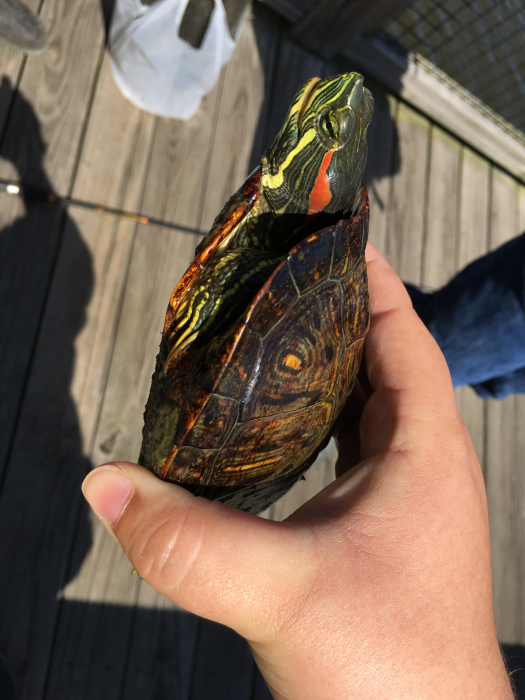Hypovitaminosis is a condition that occurs when there is insufficient intake of certain substances in the body compared to their expenditure. The lack of certain elements provokes various disorders and is the cause of many diseases in red-eared turtles.
Material Content:
Vitamin A deficiency
Vitamin A (retinol) provides the growth of animals and the normal course of a number of processes in the body. With its deficiency, violations such as desquamation of epithelial tissues are possible not only in the skin, but also in the conjunctiva, renal tubules, and other organs. And with a lack of this element during pregnancy, various disorders in the fetus develop.

Vitamin A deficiency appears with a number of symptoms:
- swollen eyes
- problems with molting;
- peeling of the skin, dermatitis;
- exfoliation of the horn flaps;
- development of blepharoconjunctivitis, blepharitis;
- prolapse of the organs of cloaca;
- appetite disorders, malnutrition, lethargy (rarely);
- proliferation of horn tissue.
On a note. Often the signs of hypovitaminosis are similar to the manifestations of a bacterial infection. Discharge of transparent exudate from the sinuses is possible.
As a treatment, injections of vitamin A are used as part of Eleovit. 2 or 3 injections may be prescribed at intervals of 2 or 3 weeks, respectively. Dosage - 0.6 ml / kg. Oil droplets for administration through the mouth to turtles are not suitable, this is fraught with an overdose and subsequent death of the reptile.
With the right treatment, the painful symptoms disappear after 2-6 weeks. But if after 14 days there is no improvement, it is necessary to additionally conduct a course of antibiotic treatment.
How to feed the red-eared turtle to provide it with a sufficient amount of retinol? After all, it is better if vitamins enter the body with food, and not as part of special additives.It is necessary to introduce beef liver and fish entrails into the diet of the animal.
Lack of Vitamin D3 and Calcium
A lack of vitamin D3 (cholecalciferol) and calcium occurs due to an unbalanced diet of the animal. And also with inadequate lighting, both natural and artificial. In addition, the use of certain products, in particular, cabbage, leads to the fact that calcium is washed out of the body. Because of this, osteopenia occurs. This is a collective term for a number of disorders in which bone mass becomes abnormally low - osteoporosis, osteomalacia, fibrocystic osteitis.

These conditions are characterized by softening and deformation of the shell. In normal condition, it should be even, and streamlined in aquatic turtles.
Other symptoms depend on the age of the reptile. In young and young individuals, the carapace is bent at the edges. In adults, it fails in the back, becomes lighter and flatter. In the elderly, the carapace may remain hard, but on palpation it appears empty, similar to plastic. In this case, its color changes to a lighter.
As well as a lack of vitamin D3 and calcium, bleeding, prolapse of the cloaca, fractures of the extremities, paresis can indicate the animal moves with difficulty. At the extreme stages, pulmonary edema, diffuse hemorrhage, acute heart failure and other disorders that can lead to death are possible.
If the tortoise has a soft shell, or other symptoms of hypovitaminosis are observed, an urgent need to show it to a specialist. The treatment regimen depends on the stage and characteristics of the course of the disease process.
At the first and second stages of rickets, when the functions of the limbs are not disturbed and there are no bleeding, paresis and swelling, such therapeutic measures are prescribed:
- Injections of calcium gluconate 10% or calcium borgluconate 20% once every 1 or 2 days at a dosage of 1.5 ml / kg. The course is up to 2 weeks.
- Reception of Pananginum within 10 days. Dosage - 1 ml / kg. Potassium and magnesium contained in the preparation help the absorption of calcium.
- Ultraviolet irradiation for 10-12 hours a day until the symptoms disappear.
- The use of calcium supplements 1-2 times a week at a dosage determined by the veterinarian.
- Diet correction - the introduction to the daily menu of shrimp or snails with shell, fish with small bones.
Therapy takes from 14 days to 2 months.
In the third and fourth stages, when rickets occurs against a background of paresis, fractures, anorexia and shortness of breath, treatment is carried out depending on the symptoms, but calcium injections are required. As a rule, it takes several months to recover.
The correct maintenance of the red-eared turtle will help prevent dangerous violations. Namely, the organization of nutrition (in the diet should be enough calcium and vitamins) and providing good lighting with a special UV lamp.












